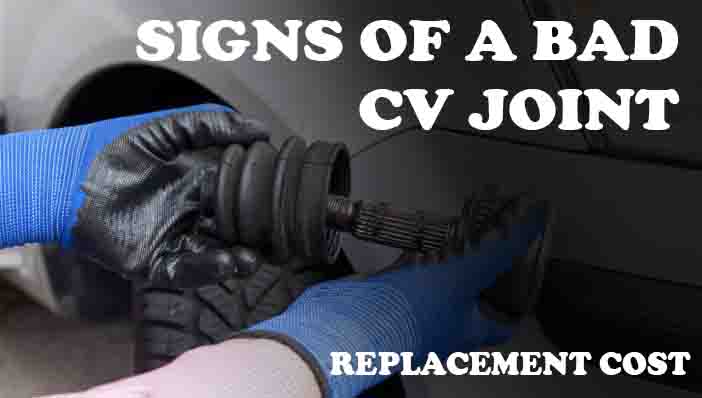There are two types of CV axles: constant velocity axles and constant speed axles. An axle with constant velocity is referred to as a half shaft since it transfers power from the transmission to the wheels, making it possible for the vehicle to move forward. It is a very important piece of engineering, so you should keep an ear out for indications that it may be giving off signs that it is malfunctioning. If you notice any of these symptoms, there is a good chance that you have a bad CV axle, so please take your vehicle to your nearest Chevrolet service center as soon as possible.
During suspension movement, the CV joints ensure that the suspension is able to transfer power from the engine to the wheels. In this article, we will explain how to tell when a CV joint is failing and how much it will cost to replace it.
Table of Contents
CV Joint Location
Normally, the CV Joint can be found near the outer part of the suspension at each drive wheel, behind the brake discs and the hubs of the wheels.

There is a CV joint on each wheel of a 4WD vehicle; if it is not a 4WD vehicle, each drive wheel has only one CV joint.
Without removing the CV joint boot, you will not be able to see the CV joint itself, since it is covered with a CV joint boot.
Bad CV joints: 5 symptoms
As an integral part of the axle shaft, the CV joint is also known as the constant velocity joint. As a result of its importance, this part cannot be ignored because it affects whether or not the car can move forward or backward.
CV joints are most commonly afflicted by problems caused by a lack of grease, as the part is not adequately lubricated due to the lack of grease. The cause of this problem is usually a broken boot on the CV joint. Over time, this will result in all sorts of debris being thrown into the joint, which will cause significant wear and tear on the joint as a result.
There are some symptoms of a bad CV joint that you should be aware of in order to help you avoid them. You will be able to spend much less money on the repairs or replacement work if you are able to spot this issue as early as possible. Here are some signs that we should be aware of:
CV joints that are bad or failing can cause the following symptoms:
Turning makes knocking noises
If you notice a knocking sound from your car while you are turning, that is a common symptom of a bad CV joint. As a result, joints may not be properly lubricated or may wear out over time as a result of not being properly lubricated. You are likely to be closer to total breakage if the sound you hear is louder than normal.
It is for this reason that all car owners should pay attention to the sounds that their vehicles emit on a daily basis. As the part’s wear increases, the noise will become audible at first, but as the part’s wear progresses, the noise will become increasingly noticeable.
In addition to this sound, there is also a metallic screeching sound that can be described as a metallic screech. Typically, the noise is most noticeable when the vehicle is accelerating and when the steering wheel is turned. It is likely that you will not have to wait long for the part to completely break after you notice this happens.
Excessive Vibration
If your CV joint is on its way out, then you will probably notice that it is vibrating a lot more than usual if you have the CV joint on its way out. When these vibrations are powerful, they can render normal driving practically impossible in some cases.
This is when you need to have a professional take a look at your vehicle so they can determine what is wrong with it. It should be noted, however, that even minor vibrations can cause concern.
Problems with the steering wheel
If it gets to the point that you are having difficulty turning your car, then it is most likely that your CV joint is nearing the end of its life. In spite of the fact that there could be many reasons for steering problems, this particular component is often the cause of the problem.
There is a real danger here in the sense that your vehicle will suddenly stop moving forward or backwards if the part is snapped.
Leakage of grease
It is common for grease to leak out from the boot of a CV joint when it is damaged. It is important that you take your car to be checked immediately if you see grease under your car or on your tires.
A broken CV joint boot is often the cause of the CV joint going bad because dirt, dust, and water will get into the CV joint and wash away the grease as a result of dirty, dusty and wet conditions in the CV joint.
Having a problem with the CV axle is one of the more common signs that you might have a problem with the system. It is likely that a complete replacement will be needed if it has reached this point.
Vehicle control problems
CV joints that are worn out and damaged often cause loss of control. Whether it is a problem with turning or maintaining a straight course on the road, this can be just about anything.
Even on a flat area of the road, if your car is particularly bouncy, this could pose a problem even if it is driving on a flat surface. The more wear and tear the part undergoes, the more severe the problem will become. In the event that the joint becomes worn down to the point where it becomes unsafe, it can be extremely dangerous.
Cost of replacing a CV joint
Depending on the model of the car and labor costs, the cost of replacing a CV joint is usually between $150 and $850. The price of a CV joint ranges from $50 to 150 dollars, while the labor cost of replacing a CV joint is between $100 and $700 dollars.
In order to determine how much it will cost you to replace the CV joint in your vehicle, several factors will need to be considered. It is essential that you take into account these things before moving forward.
In order to determine the cost of replacing this part, we need to consider some factors, such as:
- The mechanic – This part needs to be repaired by a mechanic who is skilled and can do this for a reasonable price. Getting quotes from a few different mechanics is a good idea when you are thinking about having your car repaired. This is the best way to ensure that you do not overpay for the service. Taking your vehicle to a shop that has a good reputation is also a crucial consideration for you.
- Car Type – The type of car you own will also have a bearing on the amount of money you will have to pay for this type of repair. In some cases, it is relatively easy to replace the CV joint on a car, while in others, it might be quite complicated.
- Parts Cost – It is possible for the price of CV joints to vary widely depending on the car model and the brand of CV joint used in the car. There is no doubt that buying original parts will cost more, but you will be getting a better quality part.
Conclusion
It is also important to note the make and model of the vehicle you own, as well as the difficulty of performing the replacement job on that vehicle. In essence, the longer it takes them to provide the service, the more expensive it will be.
Your auto technician or mechanic should also make sure that the boots and axles can be properly inspected, the latter being particularly important since this is a large service job. If there is grease on the tires, there may be a leak coming from the boots of the CV when there is grease on the tires.
Additionally, if you hear any very loud clicking sounds when you turn, it is likely that you need to also replace the axle if the clicking is very loud.
CV Joint FAQs
Having a damaged CV joint does not mean that you are only able to drive a certain distance with it, as the length you can drive depends on how severe the damage is and how you drive. If the CV joint has been damaged, it is very important that you have it repaired or replaced as soon as possible, as driving a vehicle with a damaged joint can result in more extensive damage and even the failure of the axle if the joint is not repaired or replaced in time.
Often, a CV joint that goes out is accompanied by a loud popping or knocking noise when the car is turned or accelerated; as a result, the car can shake or wobble. If the joint fails in a severe manner, the car may become immobile as a result, and this can cause the car to be completely undriveable.
The CV joint can be damaged by a number of things, but the most common cause is a defective CV joint boot that is allowing dirt and water to enter the joint. It is also possible for the CV joint to become damaged and worn over time as a result of constant friction between the CV joint and the surrounding bones.
If you are not familiar with working on cars, it could be quite challenging and messy to replace a CV joint if you are not experienced in the field. It is also possible that you will need some special tools depending on what model of car you have. You should make sure you are equipped with all of the necessary tools and knowledge in order to perform the replacement yourself if you decide to attempt it yourself.
An important factor that influences the lifespan of a CV joint is the model of the car, the driving conditions, and the level of maintenance (such as lubrication). On the other hand, they typically last between 70,000 and 120,000 miles on average. You may only be able to drive them for around 50,000 to 70,000 miles if you drive in harsh conditions.
